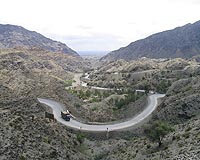| . |  |
. |
Washington (AFP) Dec 16, 2010 The United States and its allies have waged war in Afghanistan for more than nine years, longer than the Soviet army in the 1980s, but the White House said Thursday a troop buildup would pave the way for an eventual withdrawal by 2015. Since the war began in 2001, the strategy of the US-led force has changed dramatically. -- WAR ON TERROR: 2001 Less than a month after the September 11 attacks, then president George W. Bush -- declaring a "war on terror" -- launches an assault on Afghanistan to strike at Al-Qaeda, and to topple the Taliban regime for giving safe harbor to Osama bin Laden's network. The Americans rely on a small force of CIA paramilitary teams, special operations forces and US warplanes to back up the Taliban's Afghan rivals -- the Northern Alliance. The Taliban fall from power within days as Al-Qaeda training bases are knocked out, but bin Laden and his associates flee over the border into Pakistan. About 1,000 US Marines deploy later in November, the first substantial ground forces that later rise to about about 10,000 in 2002. -- FORGOTTEN WAR: 2002-2007 The US focus shifts to Iraq, as Bush orders an attack on Iraq in 2003 to "disarm" Saddam Hussein's regime. US forces struggle against an Iraqi insurgency and spiraling sectarian violence, overshadowing the war in Afghanistan. The Taliban and other Islamist militants regroup and re-emerge by 2005, exploiting sanctuaries in neighboring Pakistan while staking out strongholds along the eastern border and in the mainly Pashtun south. US troop levels hover around 20,000, rising to 27,000 in February 2007. "In Afghanistan, we do what we can," Admiral Mike Mullen, chairman of the Joint Chiefs of Staff, said in 2007. "In Iraq, we do what we must." -- WAKE UP CALL: 2008 With Taliban attacks on the rise, the Bush administration faces mounting criticism that Afghanistan has been neglected. Both presidential candidates promise to send more troops, with Barack Obama arguing that Iraq has served as a "distraction." The US commander, General David McKiernan, appeals for major reinforcements, advocating a counter-insurgency strategy designed to win over Afghans instead of merely targeting Taliban forces. At the end of his term, Bush orders thousands of troops to Afghanistan, but far less than the 30,000 requested by McKiernan. -- OBAMA'S WAR: 2009 During the first months of his presidency, Obama decides to double the number of troops on the ground, with the force rising to 68,000, while unveiling plans to end the Iraq mission. He says the aim of the war is to "disrupt, dismantle and defeat" Al-Qaeda. After a protracted debate inside the administration that pits US military coommanders against some advisers in the White House, Obama announces in December a "surge" of 30,000 additional troops, bringing the US contingent to nearly 100,000 along with nearly 50,000 allied troops. The strategy focuses on securing key towns in the Taliban's southern strongholds while building up Afghan forces. At the same time, the CIA expands a covert bombing campaign against Al-Qaeda and Taliban leaders in neighboring Pakistan, using unmanned aircraft. Along with the troop buildup, Obama sets a deadline of July 2011 to start the gradual withdrawal of US forces, but the pace of the drawdown remains unclear. -- THE WAY OUT: 2014 Given frustrations with the Kabul government and the drawn-out war, US officials in 2010 talk about "Afghan good enough," looking for more realistic goals to clear the way for an eventual exit. At a November summit, NATO backs a plan for Afghan forces to take over security by the end of 2014, with the transition starting in 2011. Pentagon officials say the 2014 date is an "aspirational" goal. The White House policy review issued Thursday calls for handing over security to the Afghans in some districts in "early" 2011 but acknowledges the persistent problem of militant sanctuaries in Pakistan.
Share This Article With Planet Earth
Related Links News From Across The Stans
 US missile kills up to seven in Pakistan's Khyber: officials
US missile kills up to seven in Pakistan's Khyber: officialsPeshawar, Pakistan (AFP) Dec 16, 2010 A US missile strike killed seven militants in Pakistan's tribal district of Khyber on Thursday, local security officials said, in an apparent expansion of America's covert drone campaign. The United States does not as a rule confirm drone attacks, but its military and the Central Intelligence Agency operating in Afghanistan are the only forces that deploy the aircraft in the region. Wash ... read more |
|
| The content herein, unless otherwise known to be public domain, are Copyright 1995-2010 - SpaceDaily. AFP and UPI Wire Stories are copyright Agence France-Presse and United Press International. ESA Portal Reports are copyright European Space Agency. All NASA sourced material is public domain. Additional copyrights may apply in whole or part to other bona fide parties. Advertising does not imply endorsement,agreement or approval of any opinions, statements or information provided by SpaceDaily on any Web page published or hosted by SpaceDaily. Privacy Statement |